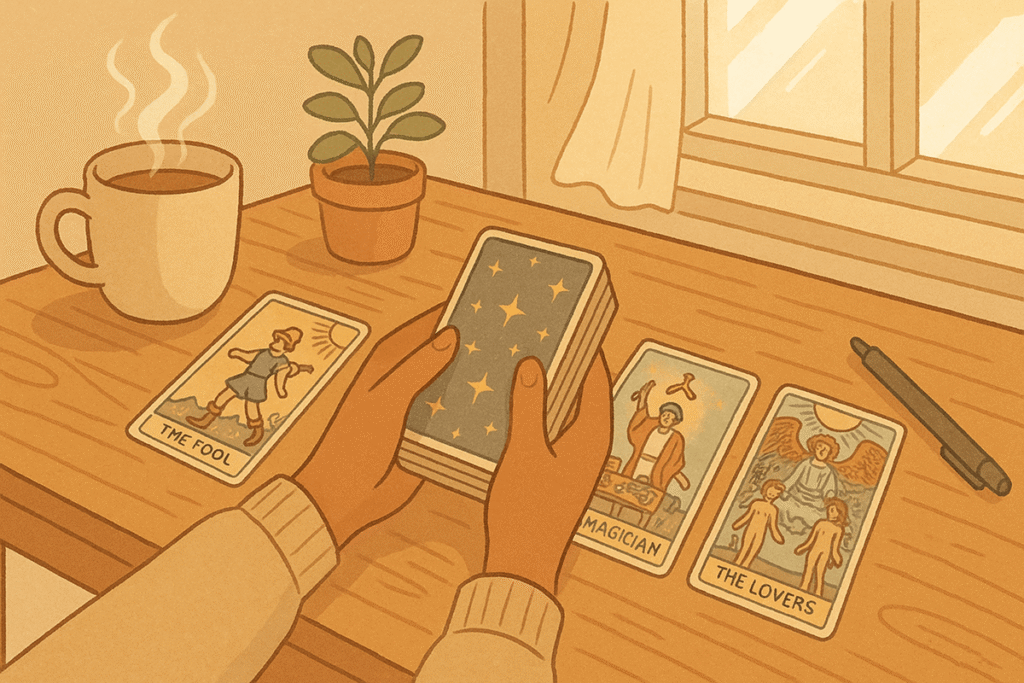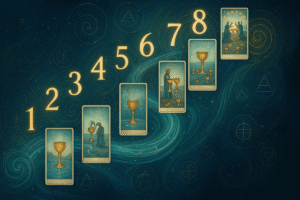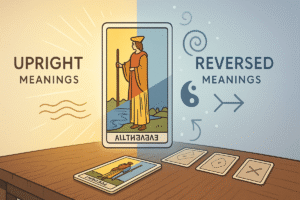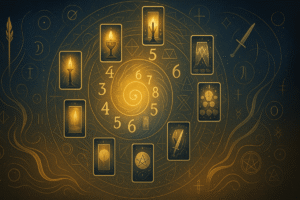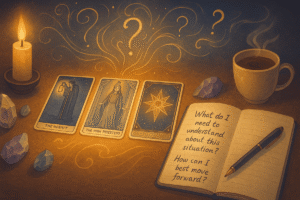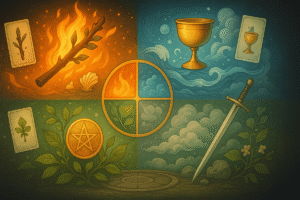Table of Contents
There’s something special about unwrapping a new tarot deck. The crisp edges, the fresh smell of cardstock, the anticipation of what insights might unfold. Yet that initial excitement can sometimes give way to uncertainty. How do you transform this collection of 78 cards from a mere purchase into a personal tool for reflection and growth?
The process of bonding with your new tarot deck isn’t about supernatural rituals or mystical ceremonies. Instead, it’s about creating familiarity, building comfort, and establishing your own unique relationship with the imagery and symbolism. Think of it like getting to know a new friend. You wouldn’t expect to understand someone completely after one conversation, would you?
Perhaps you’ve heard different approaches from various tarot enthusiasts. Some suggest sleeping with the deck under your pillow, others recommend elaborate cleansing ceremonies. While these methods work for some people, they’re not necessary for everyone. What matters most is finding practices that resonate with your personal style and beliefs.
Getting to Know Each Card Individually
The most fundamental way to connect with your new deck involves spending time with each card separately. This might sound tedious at first, especially when you’re eager to dive into readings. However, this patient approach pays dividends in understanding and familiarity.
Set aside a quiet evening when you won’t be interrupted. Pour yourself a cup of tea or coffee, find a comfortable spot, and simply look through your deck card by card. Don’t rush this process. Notice the colors that draw your attention, the symbols that spark curiosity, the figures that seem to speak to you.
I find it helpful to pause at cards that trigger an immediate emotional response, whether positive or negative. What is it about The Tower that makes you uncomfortable? Why does the Three of Cups make you smile? These initial reactions often reveal something meaningful about your relationship with the card’s energy.
Some people like to journal about each card during this process, but honestly, that can feel overwhelming with 78 cards. Maybe just jot down notes about the ones that really stand out. The goal isn’t to memorize traditional meanings but to notice your own instinctive responses.
Creating Your First Deck Interview
The deck interview has become a popular practice in modern tarot communities, and for good reason. It’s essentially a conversation starter between you and your new cards. The process involves asking your deck a series of questions about how it prefers to work with you.
A simple interview spread might include questions like: What do you want me to know about you? What are your strengths as a deck? What should I be aware of when working with you? How can we work together effectively? What do you want to teach me?
Draw one card for each question and spend time reflecting on how the imagery might relate to your query. Don’t worry if the connections don’t seem obvious immediately. Sometimes the most meaningful insights come from sitting with uncertainty for a while.
The beauty of this exercise lies not in receiving definitive answers but in starting a dialogue with your intuition. You might discover that your deck seems particularly suited for questions about relationships, or perhaps the cards that appear suggest a focus on practical matters rather than abstract concepts.
Establishing a Daily Draw Practice
Nothing builds familiarity quite like consistency. Committing to a daily card draw for your first week (or even month) with a new deck creates regular touchpoints for connection. This doesn’t need to be complicated or time consuming.
Each morning, or whenever works best for your schedule, shuffle your deck and draw a single card. Instead of trying to predict what your day will bring, use the card as a prompt for reflection. What qualities does this card represent that you might want to embody today? What challenges or opportunities does it suggest you pay attention to?
Keep a simple record of these daily draws. You might be surprised by patterns that emerge or by how differently you interpret the same card when it appears multiple times. This practice also helps you become familiar with your deck’s shuffling style and how the cards feel in your hands.
Some days the card will seem perfectly relevant to your circumstances. Other days, the connection might feel forced or unclear. Both experiences are valuable and normal. The goal is building comfort with uncertainty and trusting your interpretative instincts.
Physical Bonding Through Handling
This might sound obvious, but actually handling your cards regularly is crucial for developing familiarity. Different decks have different feels. Some are slick and smooth, others have a rougher texture. Some shuffle easily, others feel stubborn in your hands.
Spend time just shuffling without any particular purpose in mind. Try different shuffling techniques and see what feels natural. Some people prefer the riffle shuffle, others like the overhand method. There’s no right or wrong way, just what works for you and your cards.
Notice how the deck responds to your handling. Do cards tend to stick together? Do certain cards seem to jump out frequently? These physical characteristics become part of your relationship with the deck and can inform how you approach readings.
I sometimes carry a few cards with me during the day, just to get used to their size and weight. It might seem silly, but this kind of casual contact helps the deck feel less foreign and more like an extension of your own reflective practice.
Creating Personal Associations
While traditional card meanings provide a helpful foundation, developing your own associations with each card makes your readings more meaningful and authentic. This process happens naturally over time, but you can encourage it through intentional practice.
Try looking at a card and noting the first word or feeling that comes to mind, regardless of what you think the card “should” mean. These initial impressions often prove more insightful than memorized interpretations from books.
Consider creating your own keywords for each card based on your personal responses. The Four of Pentacles might traditionally represent holding onto resources, but perhaps in your experience it consistently appears when you’re being overly cautious about taking risks. These personal meanings develop through experience and reflection.
Don’t worry about conflicting with traditional interpretations. Your deck works with your intuition, not some universal database of correct meanings. Trust your instincts, even when they seem to contradict what you’ve read elsewhere.
Incorporating the Deck into Your Routine
Integration works better than separation when it comes to bonding with a new deck. Instead of keeping your cards for special occasions only, consider ways to incorporate them into your regular routines.
Maybe draw a card while your morning coffee brews. Perhaps pull one before important conversations or decisions as a way to center yourself and consider different perspectives. Some people like to end their day with a reflection card, thinking about what lessons or insights the day offered.
The key is finding natural moments where a brief pause for reflection feels helpful rather than forced. Your tarot practice shouldn’t feel like another obligation on your to do list. It should feel like a supportive tool for navigating daily life with greater awareness and intention.
These small, consistent interactions often prove more valuable than lengthy reading sessions. They help establish tarot as a practical resource rather than something reserved for dramatic moments or major decisions.
Reflecting on Your Growing Relationship
After spending time with these practices, take a moment to notice how your relationship with the deck has evolved. Which cards do you find yourself drawn to repeatedly? Are there any that consistently challenge or confuse you? How has your comfort level with the imagery changed?
This reflection isn’t about judging your progress or comparing yourself to other tarot readers. It’s about acknowledging the unique connection you’ve developed with this particular set of cards. Every deck relationship is different, just as every friendship has its own character.
Perhaps you’ve discovered that your deck seems especially helpful for questions about creativity, or maybe it consistently offers practical rather than emotional guidance. These observations help you understand how to work with your cards most effectively.
Remember that bonding with a tarot deck is an ongoing process, not a destination. Your relationship will continue to deepen and change as you both grow. The practices outlined here simply provide a foundation for that evolving connection.
The most important thing is approaching your new deck with patience, curiosity, and openness. Trust that familiarity will develop naturally through consistent, mindful interaction. Your cards are ready to support your journey of self reflection whenever you are ready to begin.
Frequently Asked Questions
How long does it take to bond with a new tarot deck?
Bonding with a tarot deck is an ongoing process that varies for each person, but most readers suggest spending at least a few weeks with regular practice before feeling truly connected. Some practitioners recommend working exclusively with your new deck for the first month, while others find that consistent daily draws over a week or two begin to establish familiarity. The important thing is not to rush the process; you can start using your deck while the bond strengthens naturally through continued interaction.
Can I use my deck for readings before I feel fully bonded with it?
Yes, absolutely. In fact, using your deck for simple readings is one of the best ways to strengthen your connection with it. Start with straightforward one or three card draws for yourself rather than complex spreads or readings for others. These light readings help you understand how your specific deck communicates and responds to questions. Think of it as having conversations that help you get to know each other better; the bond will deepen through this practical use.
What should I do if certain cards in my new deck confuse or make me uncomfortable?
Cards that trigger strong reactions, whether positive or negative, often become your most meaningful teachers. Instead of avoiding uncomfortable cards, spend extra time with them through journaling or meditation. Ask yourself what about the imagery creates that reaction and what it might be inviting you to explore within yourself. These challenging cards frequently hold the most valuable insights for personal growth once you sit with them patiently.
Is it normal for my new deck to feel awkward or difficult to shuffle at first?
Completely normal. Every deck has its own physical characteristics based on card size, finish, and weight. Some decks are slick and slide easily, others have more grip and require different handling. Spend time practicing different shuffling techniques to find what works best for you and this particular deck. The physical awkwardness usually resolves within a week or two of regular handling as both you and the cards become accustomed to each other.

